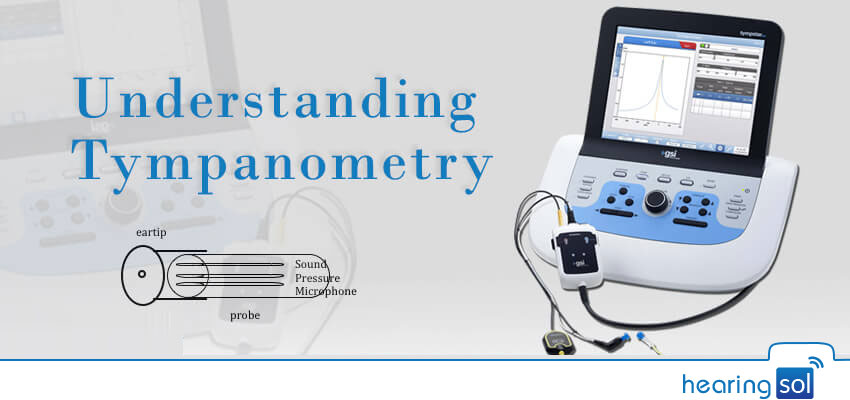
There are many tests that makeup through evaluation and act like pieces of a puzzle which when put together helps to determine the type and cause of hearing loss.
One such middle ear test is tympanometry. Tympanometry is a type of test which is helpful in determining if the hearing loss can be helped by hearing aid or any medical treatment is available to treat it.
You can purchase the latest hearing aids at a fair price through HearingSol, If you need any assistance or you have a query regarding Tympanometry or Hearing Loss, feel free to call us at +91-9327901950. We are always here to help you.
The tymp test method is used to assess the functioning of the middle ear. Tympanometry represents its results in the form of a graph called a tympanogram.
Tympanometry was developed by Terkildsen et al in the 1950s for measuring middle ear pressure. It has contributed a lot to clinical diagnosis and has become a routine part of the audiological test battery.
The probe tone offered by Tympanometer is 226 Hz, though it can give different results on other frequencies. This tone has some advantages when testing adult ear because it is stiffness dominated at this frequency.
In this in-depth article, we have tried to answer every possible question related to Tympanography, Tympanograms as well as an ear pressure test.
What is Tympanometry?
Tympanometry is the examination which is used to diagnose the condition of the middle ear, the mobility of the tympanic membrane.
The tympanic membrane is a thin tissue separating the middle and outer ear segments from each other. For your child tympanometry may be performed every week for several months to figure out the change in the fluid over time.
The Tymp test also helps to examine the conduction bones by generating air pressure changes in the ear canal. It becomes easier for doctors to diagnose the problems in the middle of the ear.
This is done to record the quantity of fluid your infant has collected in his middle ear over a period of time.
Understanding Tympanometry
Tympanometry checks whether someone can get the treatment for the hearing loss by a hearing aid or not and whether the treatment will give relief or not.
Tympanometer consist of the following; air pump, a probe with a loudspeaker, a microphone, and a manometer. There is no risk related to the tymp test.
Therefore, parents, who have children middle ear problems can easily take this test without giving a single thought.
This method is used to diagnose ear disorders which may lead to hearing loss, especially children. However, in kids, the diagnosis of symptoms of the middle ear is not an easy task.
That’s why tympanometry is suggested as an additional diagnostic tool by examining the amount of fluid present or not present in the middle ear.
This test helps in determining various factors. Some of the factors are –
- Presence of fluid in the ear
- The tear in the eardrum or tympanic membrane perforation
- Eustachian tube dysfunction, this tube connects the middle ear to the nasopharynx
- Middle ear infection (Otitis media)
Read more:- Ear Infection Is One Of The Main Cause For Hearing Loss
This test is used in conjunction with other tests such as audiometry and otoscopy. Tympanometry is always performed after the otoscopy examination.
Although tympanometry is used simultaneously with pneumatic otoscopy when the kid is seven months old or has any kind of hearing or ear difficulty.
According to health professionals, tymp test and otoscopy can be complementary. The reason is pneumatic otoscopy gives a qualitative estimate of the mobility of the tympanic membrane whereas the tymp test produces more quantitative information ( for example graphic and numeric data about taking of acoustic energy by the middle ear system, produced positive and negative pressures and ear canal volume).
Otoscopy test with tympanometry enhances the reliability of the diagnosis as there are several ear canal and eardrum abnormalities that in some cases cause might cause different types of abnormalities which can easily be traced through tympanogram. The graphics representation of tymp test data is the tympanogram.
Tympanogram represents the relationship between the air pressure in the ear canal and the movement of the eardrum, or tympanic membrane, and the tiny bones in the air-filled middle ear space.
When the doctor provides eardrums with any type of voice, some part of it is absorbed and sent through the middle ear while the remaining sound is reflected back. Tympanometry provides some extra information Eustachian Tube Functioning.
For Further info:- What are Symptoms of Eustachian Tube Dysfunction?
How Is Tympanometry Performed?
Tympanometry is performed by a hearing healthcare professional or a doctor. The test can be performed in any hearing clinic by any of the audiologist/professional.
Before start examining through the hearing test, a doctor always makes sure that your ear does not contain any type of earwax or any other thing which can affect your ear.
The instrument used for this testing is an otoscope. Firstly the specialist inspects the ear canal and eardrum visually and then using a lighted scope. It should be checked if there is no earwax or a foreign object obstructing the eardrum.
Then after performing otoscopy, your doctor will use another instrument that will be placed in the ear i.e. a probe with a flexible rubber tip.
The probe will cause a change in the air pressure of the ear canal as you hear some low-pitched tones. This pressure change feels similar to that of the takeoff and landing of a plane, which may be uncomfortable.
He will measure your eardrum’s movement and record it as the pressure keeps changing. Moving, speaking, or swallowing during the test may give incorrect results.
If a child is there for tympanometry, he/she should be explained about the test beforehand with the help of a dummy. This will prepare them for the loud noises and practice being still.
It will maximum take two minutes for both the ears. People from any ages bracket can have tympanometry, as there is no risk related to it.
What Is The Feeling During The Test?
Tympanometry is very simple, in fact, you have to do a thing that you have to cooperate with your doctor. It is comfortable and does not give any type of pain.
You will hear a soft tone in your ear while testing and have a good feeling of having a soft earbud present in the ear.
Working on Tympanometry
Firstly, a professional will test the presence of earwax and other particles. Then they insert the earbud which tends to be soft to check the capacity of your eardrum by moving it and changing the air pressure of the ear.
During the tymp test, you will hear a dim noise, you will hear a voice which is due to the measurement of the capacity.
If the tympanogram is not normal then there will a fluid behind the eardrum. If the tympanogram is normal then there will be no fluid present in the middle ear.
It shows the normal movement of the middle ear, eardrum, and the conduction bones. The tympanogram gives relief for both the children and adults.
Read more:- Causes, Symptoms & Treatment For Ear Wax Buildup Blockage
Interpreting the Tympanometry Results
The tympanometry result indicates; ear canal volume (cm3), the max pressure (daPa), and the peak compliance (ml). The test plays a crucial role in distinguishing between conductive hearing loss and sensorineural hearing loss.
And it also allows us to view the upper auditory pathways and the reflex contraction of the middle ear muscles.
Normal Results:
- No fluid in the middle ear
- Smooth Eardrum
- Normal Pressure in the middle ear
- Normal movement of conduction bone and eardrum
Both adults and children can use this test since there is no risk in it. Even if the results are normal it can provide information regarding fluid or any middle ear concerns.
The presence of fluid in middle ear space may not allow movement of eardrum and transmission of sound. This condition may not require the use of hearing aid to correct the hearing loss but must consult a physician.
Normal pressure in the middle ear varies from +50 to -150 deca pascals (daPa). Decapascals is the measurement unit of air pressure.
Abnormal Results:
- Presence of fluid in the middle ear
- Eardrum blocked by earwax
- Perforation of the tympanic membrane
- Scarring of tympanic membrane from the frequent ear infection
- Tumors in the middle ear
- Pressure beyond normal range in the middle ear
- Lack of contact in conduction bones of the middle ear
- Middle ear infection
- Some problem with the Eustachian Tube
After getting abnormal test results, the doctor will conduct some additional tests as well as a follow-up appointment with a specialist.
Types of Tympanogram
A tympanogram depending on the diagnosis gives results related to the compliance of the middle ear system, middle ear pressure, and ear canal volume.
Compliance is shown in a vertical manner on the tympanogram and is measured in ml or mmho. In case the middle ear cavity pressure is the same as the external auditory canal pressure then the tympanogram shows maximum compliance of the middle ear system.
The graphs obtained after conducting tympanometry are classified into the following types based on the compliance and the peak of the graph:
1. Type A Tympanogram
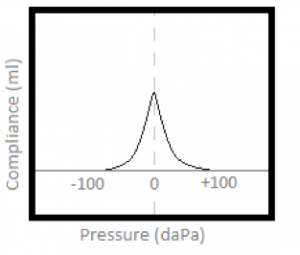
Type A resembles a teepee and shows a normal middle ear system that has no fluid and an intact tympanic membrane. It also indicates the absence of any kind of physiological anomalies that usually prevent the entrance of sound into the cochlea from the middle ear. an intact tympanic membrane. It shows compliance from 0.3-1.5 ml.
2. Tympanogram Type AD
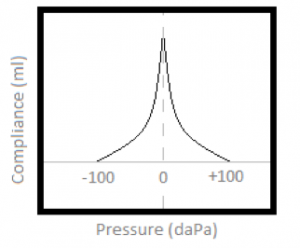
Type AD shoes high Compliant middle ear system and compliance of more than 1.5 ml. This type shows Scarred or Monomeric T/M, Loss of elasticity in T/M, and Ossicular Disarticulation such as Fractured Ossicles.
3. Tympanogram Type AS
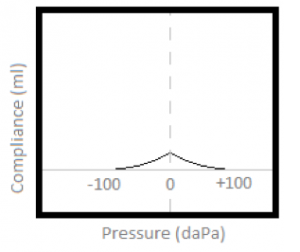
Type AS indicates less Compliant middle ear system and compliance of fewer than 0.3 ml. This type shows Scarred or Thickened EarDrum, Tympanosclerosis, and Ossicular Fixation.
4. Type B Tympanogram
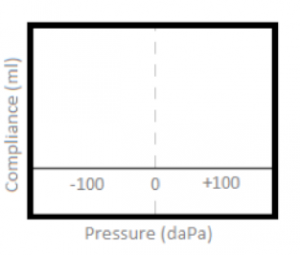
Type B shows a flat line. It indicates a constant middle ear pathology which is a build-up of fluid or ear infection behind the eardrum. A flat tympanogram (type B) also indicates a stiff tympanic membrane. Some of the cases of type B shows –
- presence of hole inside the eardrum,
- the dissimilarity lies in the ear canal volume,
- a larger volume of the ear canal shows eardrum perforation.
- No identifiable peak in the graph
5. Tympanogram Type B-High
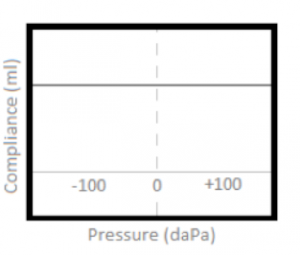
Type B – high indicates middle ear involvement from a perforation. It shoes no identifiable peak in the graph. This type shows normal limit exceeded by ear canal volume equivalently, much more than 1.5 cm3
6. Tympanogram Type C
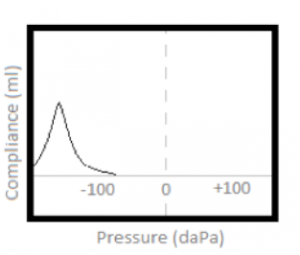
Type C also resembles a teepee, although it is shifted negatively on the graph. This shows the presence of negative pressure inside the middle ear space.
This type of condition is usually shown in constant allergy congestion or sinus. In some of the cases, it also shows the end-stages of ear infection or cold, possible Tympanic Membrane retraction, and eustachian Tube dysfunctions, just seen before or after effusion. It indicates compliance from 0.3 to 1.5 ml.
Types C1 and C2 tympanogram are usually noticed in kids who have a runny nose. These types are the stage that is found in between which means they can also develop into a type A or type B tympanogram.
Development of Otitis Media
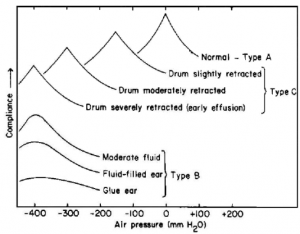
The above Tympanogram shows different stages during the development of Otitis Media. A middle ear infection is a type of inflammatory disease of the middle ear.
Tympanometry Preventions
A person should not perform tympanometry examination in case of any of the following cases –
- If he/she has recent ear surgery,
- In case his eardrum is red bulging and causing extreme pain,
- Presence of some foreign object in the canal such as grommets,
- If there is any kind of ear discharge,
- In case of a perforated eardrum,
- Presence of moisture in the ear.
What Does the Result Mean?
In children, this test shows signs of middle ear problems such as the presence of the fluid, the hole in the middle ear, ear infections many more.
There is a possibility of an error or incorrect result the fluid is present behind the middle ear as the fluid stops the movement of the eardrum and transmits the sound properly.
This condition occurs temporarily and is medically treatable. The tympanometry generally used to check the capacity and the quality of your eardrum. This test checks other difficulties in the middle ear.
It is most commonly used for children but can be used to test all the different ages. It always provides an accurate result.
Depending on the result of the tymp test your doctor will suggest other tests also for further diagnosis of your ear condition. In case your test results are abnormal then book an appointment with a specialist for further examination.
You can purchase the latest hearing aids at a fair price through HearingSol, If you need any assistance or you have a query regarding Tympanometry or Hearing Loss, feel free to call us at +91-9327901950. We are always here to help you.
Read More:

 Reviewed by Mr. Ranjeet Kumar
Sr. Audiologist, Speech Therapist & Cochlear Implant Specialist, BASLP on
Reviewed by Mr. Ranjeet Kumar
Sr. Audiologist, Speech Therapist & Cochlear Implant Specialist, BASLP on